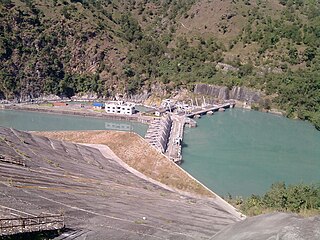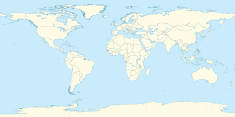
Hydroelectricity, or hydroelectric power, is electricity generated from hydropower. Hydropower supplies 14% of the world's electricity, almost 4,210 TWh in 2023, which is more than all other renewable sources combined and also more than nuclear power. Hydropower can provide large amounts of low-carbon electricity on demand, making it a key element for creating secure and clean electricity supply systems. A hydroelectric power station that has a dam and reservoir is a flexible source, since the amount of electricity produced can be increased or decreased in seconds or minutes in response to varying electricity demand. Once a hydroelectric complex is constructed, it produces no direct waste, and almost always emits considerably less greenhouse gas than fossil fuel-powered energy plants. However, when constructed in lowland rainforest areas, where part of the forest is inundated, substantial amounts of greenhouse gases may be emitted.

Kaligandaki A Hydroelectric Power Station is situated near Mirmi of Syangja District about 300 km to the west of Kathmandu and 100 km from Pokhara in the same direction in Nepal. The hydropower project is also the biggest hydropower project of Nepal. The dam and headworks are situated on the Gandaki River at the confluence of the Andhikhola whereas the power house is located downstream, around a bend in the river, in Beltari. A 5.9 km (3.7 mi) long headrace tunnel connects the reservoir to the power station which contains three 48 MW Francis turbine-generators. Owner and operator of the power plant is Nepal Electricity Authority.

The Jebba Hydroelectric Power Station, also Jebba Power Station, is a hydroelectric power plant across the Niger River in Nigeria. It has a power generating capacity of 578.4 megawatts, enough to power over 364,000 homes. The plant was commissioned on 13 April 1985, although commercial energy production began in 1983.

The Karuma Hydroelectric Power Station is an operational 600 MW hydroelectric power station in Uganda. It is the largest power-generating installation in the country.
Qorlortorsuaq Dam is a hydroelectric dam near Qorlortorsuaq in the Nanortalik district of the Kujalleq municipality in southern Greenland. It has a capacity of 7.6 MW and it generates power for the neighbouring towns of Qaqortoq and Narsaq.
The Bongolo Dam is a dam on the Louetsi River in southwestern Gabon, near Bongolo. The dam was built in the early 1990s with Canadian investment. In 2020, it was announced that the dam was going to be refurbished by Société d’énergie et d’eau du Gabon, with five faulty turbines being replaced and the renewal of the safety and security equipment.
Achwa 2 Hydroelectric Power Station is a 41 megawatts (55,000 hp) hydroelectric power plant, in Uganda.
Sahofika Hydroelectric Power Station, also referred to as Sahofika Power Station, is a 205 megawatts (275,000 hp) hydroelectric power station under construction in Madagascar.
The Nachtigal Hydroelectric Power Station is a 420 megawatt run-of-the-river hydroelectric power station under development in Cameroon across the Sanaga River, which harnesses the energy of the Nachtigal Falls. The development rights were granted to Nachtigal Hydro Power Company (NHPC), a company owned by a consortium comprising (a) Électricité de France (b) International Finance Corporation and (c) the Government of Cameroon. A 35-year power purchase agreement is in place, between Eneo Cameroon S.A. and NHPC.
The Zongo II Power Station, also Zongo 2 Power Station, is a 150 MW hydroelectric power station across the Inkisi River that harnesses the energy of the Zongo Falls in the Democratic Republic of the Congo. Construction began on 14 March 2012 and concluded in 2018. The power station was officially inaugurated on 22 June 2018 by the President of the DR Congo, at that time, Joseph Kabila.
Kinguélé Aval Hydroelectric Power Station is a 35 megawatts (47,000 hp) hydroelectric power station, under construction across the Mbei River, a tributary of the Komo River, in Gabon. The power station is the first grid-ready, privately owned hydroelectric power station in the country.
The Singrobo Hydroelectric Power Station, also Singrobo-Ahouaty Hydroelectric Power Project, is a hydroelectric power station under construction across the Bandama River, in Ivory Coast. When completed, as expected in 2023, the power station will be the first, grid-ready hydroelectric power station, developed and owned by an independent power producer (IPP) in West Africa. The energy generated here will be sold to the Ivorian electric utility company, Cienergues, under a 35-year power purchase agreement (PPA).
Bumbuna II Hydroelectric Power Station is a planned 143 megawatts (192,000 hp) hydroelectric power station in Sierra Leone. The power plant is under development by a consortium of renewable energy IPPs and investors, led by Joule Africa Limited. The energy generated here will be sold to Electricity Distribution and Supply Authority (EDSA), the electricity utility company of Sierra Leone, under a 25-year power purchase agreement.
The Ngoulmendjim Power Station is a planned hydroelectric power station across the Komo River in Gabon. The power station is under development, by a consortium comprising the French conglomerate Eranove Group and Gabonese Fund for Strategic Investments (FGIS). As of November 2021, the development was in the "financial mobilization phase".
Ruhudji Hydroelectric Power Station is a planned 358 megawatts hydroelectric power station in Tanzania. The lead developer of this renewable energy project is Tanzania Electric Supply Company Limited (TANESCO), the government-owned electricity utility company. TANESCO plans to develop the power station, as a public private partnership (PPP) project. Work is contemporaneously ongoing, along with the development of the 222 megawatts Rumakali Hydroelectric Power Station, also located in Njombe Region.
Rumakali Hydroelectric Power Station is a 222 megawatts hydroelectric power station under construction in Tanzania. The power station is under development by a consortium comprising Tanzania Electric Supply Company Limited (TANESCO), the government-owned electricity utility company and the China Gezhouba Group. The power generated at this power station will be sold to TANESCO, for integration into the national electric grid.
The Mbakaou Power Station is an operational 1.48 megawatts (1,980 hp) mini hydroelectric power station in Cameroon. Commercially commissioned in December 2021, the renewable energy project was jointly developed by the Government of Cameroon, in collaboration with IED Invest, an independent power producer (IPP) based in France, and Eneo Cameroon S.A., the Cameroonian national electric distribution parastatal company. The power generated at this power plant, amounting to 11.2 GWh annually, is sold to Eneo Cameroon, under a 20-year power purchase agreement, and is distributed to an estimated 40,000 people in the Adamawa Province of Cameroon.
The Volobe Power Station is a 120 megawatts (160,000 hp) hydroelectric power project under construction in Madagascar.
The FE2 Hydroelectric Power Station is a 36 megawatts hydroelectric power station in Gabon. Construction of this dam began in 2010. Due to lack of adequate funding, work was abandoned in 2013. In 2018, after a five-year hiatus, Tebian Electric Apparatus Stock Limited (TBEA), a Chinese independent power producer (IPP), in collaboration with the Gabonese Strategic Investment Fund, indicated their intention to invest €180 million into the development of FE2 HPP. The engineering, procurement and construction (EPC) contract was awarded to the China Gezhouba Group Company (CGGC). The energy off-taker is Société d'Énergie et d'Eau du Gabon (SEEG), the national electricity utility company of Gabon.
Chishimba Hydroelectric Power Station is a 15 megawatts (20,000 hp) hydroelectric power station that sits across the Luombe River in Zambia. The power station, first commissioned in 1959, was rehabilitated and expanded in 1971 and again expanded and modernized in the 2020s. This power station is owned by the Government of Zambia and is operated and maintained by Zambia Electricity Supply Corporation Limited (ZESCO), the national electricity utility company. The energy generated here is distributed to the city of Kasama and other parts of Kasama District.






